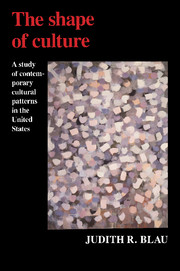Book contents
- Frontmatter
- Contents
- List of figures and tables
- Acknowledgements
- 1 Culture as structure and meaning
- 2 The American cultural landscape
- 3 Reproduction and decline
- 4 Co-occurrence, tipping in, and bridging
- 5 Organizational assembly and disassembly
- 6 Increasing returns on diminishing artists
- 7 A little more on the hobby horse
- 8 Masses and classes
- 9 The transformation of American culture
- Appendix A List of SMSAs and 1970 population in 100s
- Appendix B Sources and descriptions of cultural indicators
- Appendix C Log transformation
- Appendix D Polynomial term
- Index
- Other books in the series
5 - Organizational assembly and disassembly
Published online by Cambridge University Press: 06 July 2010
- Frontmatter
- Contents
- List of figures and tables
- Acknowledgements
- 1 Culture as structure and meaning
- 2 The American cultural landscape
- 3 Reproduction and decline
- 4 Co-occurrence, tipping in, and bridging
- 5 Organizational assembly and disassembly
- 6 Increasing returns on diminishing artists
- 7 A little more on the hobby horse
- 8 Masses and classes
- 9 The transformation of American culture
- Appendix A List of SMSAs and 1970 population in 100s
- Appendix B Sources and descriptions of cultural indicators
- Appendix C Log transformation
- Appendix D Polynomial term
- Index
- Other books in the series
Summary
Kyosai sent a picture of a crow to an exhibit, fixing the price at 100 yen. When people made remarks about the exorbitant price, he replied that the sum was but a small fraction of the price of his fifty years of study that had enabled him to dash off the picture in this manner.
W. Anderson, 1899In contrast with professional workers (for example, engineers, doctors, and veterinarians) and service workers (such as cooks, security personnel, and morticians), whose relative power and autonomy reside in the indispensability of their services, cultural workers provide services that are an accessory to the good life. For precisely this reason, cultural workers and cultural institutions are to an exceptional extent dependent on their clients and on others for their good will and support. Definitions of what constitute the criteria for work done by professionals – designing safe bridges or curing diseases – and those provided by service personnel – keeping city streets clean, catching criminals, and embalming the deceased – are relatively standardized and clear cut. While such tasks may not always be easy to carry out, there is public consensus that they have to be done and what the results should be. Moreover, the criteria for evaluation of professional and service tasks change slowly over time and are subject to legal and administrative scrutiny. Both within each profession and each service sector providers compete and co-operate with one another to perform a given task according to the same standards.
- Type
- Chapter
- Information
- The Shape of CultureA Study of Contemporary Cultural Patterns in the United States, pp. 73 - 98Publisher: Cambridge University PressPrint publication year: 1989



